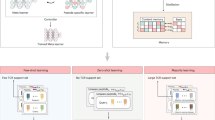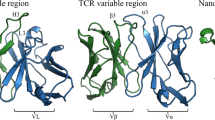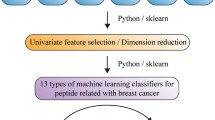Abstract
Computational methods were used to predict the sequences of peptides that bind to the MHC class I molecule, Kb. The rules for predicting binding sequences, which are limited, are based on preferences for certain amino acids in certain positions of the peptide. It is apparent though, that binding can be influenced by the amino acids in all of the positions of the peptide. An artificial neural network (ANN) has the ability to simultaneously analyze the influence of all of the amino acids of the peptide and thus may improve binding predictions. ANNs were compared to statistically analyzed peptides for their abilities to predict the sequences of Kb binding peptides. ANN systems were trained on a library of binding and non-binding peptide sequences from a phage display library. Statistical and ANN methods identified strong binding peptides with preferred amino acids. ANNs detected more subtle binding preferences, enabling them to predict medium binding peptides. The ability to predict class I MHC molecule binding peptides is useful for immunolological therapies involving cytotoxic-T cells.
This is a preview of subscription content, access via your institution
Access options
Subscribe to this journal
Receive 12 print issues and online access
$209.00 per year
only $17.42 per issue
Buy this article
- Purchase on Springer Link
- Instant access to full article PDF
Prices may be subject to local taxes which are calculated during checkout
Similar content being viewed by others
References
Schneider, G., Schuchhardt, J. and Wrede, P. 1995. Peptide design in machina: development of artificial mitochondrial protein precursor cleavage sites by simulated molecular evolution. Biophysical J. 68: 434–447.
Lohmann, R., Schneider, G., Behrens, D. and Wrede, P. 1994. A neural network model for the prediction of membrane-spanning amino acid sequences. Protein Sci. 9: 1597–1601.
Milik, M. and Skolnick, J. 1995. An object oriented environment for artificial evolution of protein sequences: the example of rational design of transmembrane sequences, in Proceeding of Fourth Annual Conference on Evolutionary Programming. MIT Press, La Jolla.CA.
Townsend, A. and Bodmer, H. 1989. Antigen recognition by class l-restricted T lymphocytes. Annu. Rev. Immunol. 7: 601–624.
Yewdell, J.W. and Bennink, J.R. 1992. Cell biology of antigen processing and presentation to major histocompatibility complex class I molecule-restricted T lymphocytes. Advances in Immunology 52: 1–123.
Falk, K., Rotzschke, O., Stevanovic, S., Jung, G. and Rammensee, H.G. 1991. Allele-specific motifs revealed by sequencing of self-peptides eluted from MHC molecules. Nature 351: 290–296.
Jardetzky, T.S., Lane, W.S., Robinson, R.A., Madden, D.R. and Wiley, D.C. 1991. Identification of self peptides bound to purified HLA-B27. Nature 353: 326–329.
Hunt, D.F., Henderson, R.A., Shabanowitz, J., Sakaguchi, K., Michel, H., Sevilir, N. et al. 1992. Characterization of peptides bound to the class I MHC molecule HLA-A2.1 by mass spectrometry. Science 255: 1261–1263.
Ruppert, J., Sidney, J., Celis, E., Kubo, R.T., Grey, H.M. and Sette, A. 1993. Prominent role of secondary anchor residues in peptide binding to HLA-A2. 1 molecules. Cell 74: 929–937.
Garboczi, D.N., Madden, D.R. and Wiley, D.C. 1994. Simultaneous space group determination and x-ray data collection. J. Mol. Blol. 239: 581–587.
Matsumura, M., Saito, Y., Jackson, M.R., Song, E.S. and Peterson, P.A. 1992. In vitro peptide binding to soluble empty class I major histocompatibility complex molecules isolated from transfected Drosophila melanogaster cells. J. Blol. Chem. 267: 23589–23595.
Hammer, J., Takacs, B. and Sinigaglia, F. 1992. Identification of a motif for HLA-DR1 binding peptides using M13 display libraries. J. Exp. Med. 176: 1007–1013.
Jackson, M.R., Song, E., Yang, Y. and Peterson, P.A. 1992. Empty and peptide-containing conformers of class I major histocompatibility complex molecules expressed in Drosophila melanogaster cells. Prac. Natl.Acad. Sci. USA 89: 12117–12121.
Parmley, S.F. and Smith, G.P. 1988. Antibody-selectable filamentous fd phage vectors: affinity purification of target genes. Gene 73: 305–318.
Scott, J.K. and Smith, G.P. 1990. Searching for peptide ligands with an epitope library. Science 249: 386–390.
Rammensee, H.G., Friede, T. and Stevanoviic, S. 1995. MHC ligands and peptide motifs: first listing. Immunogenetics 41: 178–228.
Taylor, W.R. 1986. The classification of amino acid conservation. J. Theor. Biol. 119: 205–218.
Kidera, A., Konishi, Y., Oka, M., Ooi, T. and Sheraga, H.A. 1985. Statistical analysis of the physical properties of the 20 naturally occurring amino acids. J. Prof. Chem. 4: 23–55.
Brusic, V., Rudy, R. and Harrison, L.C. 1994. Prediction of MHC binding peptides using artificial neural networks, pp. 253–260 in Complex systems: Mechanism of adaptation, Stonier, R.J. and Yu, X.S. (eds.). IOS Press, Washington, DC.
Adams, H.P. and Koziol, J.A. 1995. Prediction of binding to MHC class I molecules. J. Immunol. Methods 185: 181–190.
Gulukota, K., Sidney, J., Sette, A. and Delisi, C. 1997. Two complementary methods for predicting peptides binding major histocompatibility complex molecules. J. Mol. Biol. 267: 1258–1267.
von Heijne, G. 1986. Net N-C charge imbalance may be important for signal sequence function in bacteria. J. Mol. Biol. 192: 287–290.
Mullis, K.B. and Faloona, F.A. 1987. Specific synthesis of DNA in vitro via a polymerase-catalyzed chain reaction. Methods Enzymol. 155: 335–350.
Field, J., Nikawa, J., Broek, D., MacDonald, B., Rodgers, L., Wilson, I.A. et al. 1988. Purification of a RAS-responsive adenylyl cyclase complex from Saccharomyces cerevisiae by use of an epitope addition method. Mol. Cell. Biol. 8: 2159–2165.
Skerra, A., Pfitzinger, I. and Pluckthun, A. 1991. The functional expression of antibody Fv fragments in Escherichia coli: improved vectors and a generally applicable purification technique. Bio/Technology 9: 273–278.
Laemmli, U.K. 1970. Cleavage of structural proteins during the assembly of the head of bacteriophage T4. Nature 227: 680–685.
Smith, G.P. 1988. Filamentous phage assembly: morphogenetically defective mutants that do not kill the host. Virology 167: 156–165.
Castano, A.R., Tangri, S., Miller, J.E. HoHcombe, H.R., Jackson, M.R., Huse, W.D. et al. 1995. Peptide binding and presentation by mouse CD1. Science 269: 223–226.
Zell, A. and Marnier, G. G.1997. Stuttgart Neural Network Simulator version 4.1: University of Stuttgart.
Rumelhart, D., McClelland, J. and PDP Research Group 1996. Parallel Distributed Processing. MIT Press, Cambridge, MA.
Masters, T. 1993. Recipes in C++. Academic Press Inc., Boston.
Jameson, S.C. and Bevan, J. 1992. Dissection of major histocompatibility complex (MHC) and T cell receptor contact residues in a Kb-rstricted ovalbumin peptide and an assessment of the predictive power of MHC-binding motifs. Eur. J. Immunol. 22: 2663–2667.
Karre, K., Ljunggren, H.G., Piontek, G. and Kiessling, R. 1986. Selective reaction of H-2 deficient lymphoma variants suggests alternative immune defense strategy. Nature 319: 675–678.
Ljunggren, H.G. and Karre, K. 1985. Host resistance directed selectively against H-2 deficient lymphoma variants. Analysis of the mechanism. J. Exper. Med. 162: 1745–1759.
Nicolic-Zugic, J. and Carbone, F.R. 1990. The effect of mutations in the MHC class I peptide binding groove on the cytotoxic T lymphocyte recognition of the Kb restricted ovalbumin determinant. Eur. J. Immunol. 20: 2431–2437.
Author information
Authors and Affiliations
Corresponding author
Rights and permissions
About this article
Cite this article
Milik, M., Sauer, D., Brunmark, A. et al. Application of an artificial neural network to predict specific class I MHC binding peptide sequences. Nat Biotechnol 16, 753–756 (1998). https://doi.org/10.1038/nbt0898-753
Received:
Accepted:
Issue Date:
DOI: https://doi.org/10.1038/nbt0898-753
This article is cited by
-
Influence of allele frequency on predicting animal phenotype using back-propagation artificial neural networks
Wuhan University Journal of Natural Sciences (2011)
-
A genetic approach for building different alphabets for peptide and protein classification
BMC Bioinformatics (2008)



